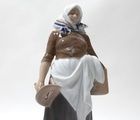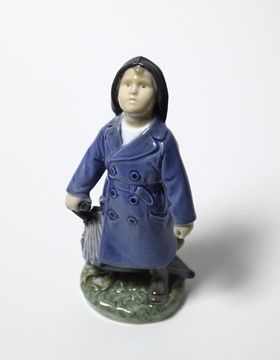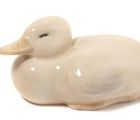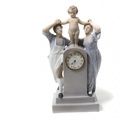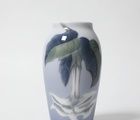
Королевская мануфактура.
Основание фабрики - 1760 г.
Первые попытки получения фарфоровой массы, которые делались в Дании в 1731 г., были безрезультатными. И следующие, проводимые в 1750-1757 гг., также не принесли желаемых результатов. И лишь открытие в 1756 г. Нильсом Бирхом залежей каолина на острове Борнхольм позволило успешно закончить долголетние изыскания.
В 1760 г. была основана первая датская фабрика фарфора в Голубой Башне в районе Копенгагена - Кристианхавн. Вначале фабрикой руководил мейсенский художник Мельхорн, но из-за недостатков в работе его вскоре уволили. На короткое время его заменил мастер фаянса из Каструпа Якуб Фортлин. Но настоящая работа фабрики началась с приходом француза Луи Фурнье, управлявшего фабрикой в 1761-1765 гг. Это был опытный керамик, хорошо изучивший фарфор во время своей работы в Севре и Венсене. Фурнье вырабатывал в Копенгагене мягкий фарфор. Состав его массы, а также модели и декор делались по образцу Севра. В основном выпускались чашки, тарелки, кувшины и вазы в стиле рококо. При украшении крупной посуды накладывали цветочные фестоны.
Преемником Фурнье стал Франц Генрих Мюллер из Копенгагена. После многочисленных проб он в 1773 г. самостоятельно овладел техникой получения твердого фарфора. И это решило дальнейшую судьбу фабрики. В 1775 г. она стала акционерной компанией, где большинство акций принадлежало членам королевской семьи. В 1779 г. фабрика перешла государству. Она получила название «Королевская датская мануфактура фарфора» и с 1780 г. имела свой магазин в Копенгагене. Мюллер руководил фабрикой до 1802 г., после чего ушел на пенсию.
Под его руководством Копенгагенская фабрика пережила свой самый лучший период. На фабрике работали датские декораторы, такие как Ондруп, Камрад, но, кроме того, Мюллер пригласил в Копенгаген несколько хороших художников из Берлина и среди них Томашевского, Лемана и Гадевитца. Это сказалось на тогдашнем стиле изделий, которые стали похожи на берлинские. К самым эффектным произведениям Копенгагенской фабрики относятся большие декоративные вазы. Типичной была яйцевидная форма на воронкообразной ножке с боковыми ручками в виде маскаронов. На крышке ваз часто помещалась фигурка пухлощекого малыша putto. Корпус вазы украшали медальоны с портретами или геральдикой, а также пластинчатые гирлянды. Иногда в медальоны помещали портретные фигуры, модные в XVIII в.
Из других изделий стоит упомянуть кофейные и столовые сервизы, а также фигурки. Декорирование столовой посуды зависело от ее предназначения. Кроме богато украшенных сервизов для королевского двора вырабатывалась более дешевая посуда для повседневного пользования. Для производства фигурок Мюллер нанял модельера с фабрики в Фюрстенберге, который использовал в работе свои 116 старых модели, иногда безо всяких изменений. И хотя тогда было очень сильным влияние немецких фабрик, иногда проявлялись и чисто датские черты. Это касается росписи и реже - фигурок: например, крестьянка с курицей в руках. Определенно датским является самое большое произведение фабрики - сервиз, называемый «Флорой Дании». Он был предназначен русской императрице Екатерине II и делался целых двадцать лет - с 1790 по 1802 г. Сервиз планировался на восемьдесят персон.
В 1796 г. Екатерина II умерла, не дождавшись окончания работы. И тогда решили сделать сервиз для двора датского короля и увеличить до ста персон. Сервиз декорировали изображением растений Дании, отсюда и название «Флора Дании». Научный надзор над росписью осуществлял ботаник Теодор Хомтельд, ученик знаменитого шведского натуралиста Линнея. Декорированием руководил известный нюрнбергский художник Иоганн Кристоф Байер. Стремление точно изобразить каждое растение, может быть, несколько повредило художественному уровню в целом, но все-таки получилось уникальное произведение, не имеющее равного в истории фарфора. Сервиз и сейчас хранится в замке Розенборг.
В 1802 г., после ухода с фабрики Мюллера, его преемником стал И. Мантей. В то время фабрика пережила самый большой кризис. Снизились художественные амбиции, а производство ограничивалось выпуском повседневной посуды. Ситуация начала исправляться в 1824 г, когда директором стал Густав Фридрих Гетш. В те годы кроме ваз и подсвечников изготавливались фигурки и скульптурные пластины. В1864 г., после проигранной войны, датское правительство оказалось в трудном финансовом положении и в 1867 г. продало Копенгагенскую фабрику А. Фальку. Новый владелец сохранил право прежнего названия фабрики и ее клейм. Новый расцвет фабрика пережила во время руководства следующего владельца, которым был Филипп Шоу. Счастливым и прибыльным событием стало приглашение в 1885 г. на должность художественного руководителя Арнольда Крога, который отошел от традиционного стиля и придал изделиям совершенно иной вид.
Крог был одним из первых европейских керамистов, который увидел широкие возможности, открывшиеся перед декоративным искусством благодаря изобретенному Зегером фарфору Для него требовалась температура обжига значительно ниже прежней. Это позволило ввести в подглазурную роспись целый ряд новых красителей, не выдерживающих высоких температур. Крог довел до совершенства искусство применения красителей. Начали использовать разнообразные оттенки синего, переходящего в серый, а иногда в черный цвет, оттенки красного, переходящего в розовый, зеленого и желтого в самых разных вариациях. Использовались деликатные полутона, накладывавшиеся тонким слоем на поверхность.
Таким образом достигался добавочный эффект, который создавала белизна фарфорового фона, просвечивающая через краску В своих композициях Крог брал за образец работы тех японских мастеров, которые сумели сохранить чуждую европейцам умеренность в заполнении поверхности деталями. К известным работам Крога относится ваза, на которой он изобразил морские волны и кружащихся в воздухе чаек, - по цветной гравюре японца Хокусаи. Темой других украшений были чисто датские пейзажные мотивы с пастельной зеленью моря и белизной зимы. Другим достижением Крога были цветные глазури на посуде. Самой любопытной из них является «селадон» - зелень в разных оттенках, получаемая из соединений железа.
Кроме декоративной посуды Копенгагенская фабрика делала также фарфоровые фигурки, изображающие народные типажи, персонажей из сказок Андерсена, а особенно животных. Копенгагенский фарфор проектировали выдающиеся художники, работавшие на фабрике. После демонстрации на парижской выставке в 1889 г. копенгагенские изделия стали известными и модными во всей Европе. Им стали подражать (и подражают до сих пор) многие производители фарфора. Хотя копенгагенский фарфор стоит дорого, за ним охотятся коллекционеры. Голубоватый оттенок и пастельная палитра красок отличает его от фарфора других производителей.
Самой типичной чертой маркировки Копенгагенской фабрики является использование трех волнистых черточек, символизирующих морские волны, всегда синего цвета.

Royal Copenhagen - датская Королевская мануфактура. Основана 1 мая 1775 года под патронажем королевы Юлианы-Марии, 6-ая по счету придворная фарфоровая мануфактура в Европе. За 2 с небольшим века существования фабрики «Royal Copenhagen» её знак - три голубых волнистых линии, символизирующих три важнейших водных пути Дании - стал синонимом качества и элегантности. «Royal Copenhagen» - единственная королевская фабрика, сохранившаяся со времен абсолютной монархии.
Поэтому до сих пор её товарный знак венчает корона. У фабрики всегда были «королевские» заказчики. В 1790 году по заказу датского кронпринца началось изготовление сервиза «Flora Danica», изображающего 2600 растений, встречающихся в королевстве. По сей день на фабрике по заказу делают точно такой же сервиз. В 1868 году мануфактура была приватизирована. Владельцем её стал купец Г.А. Фальк. С тех пор, и поныне, - это частное предприятие, сменившее несколько владельцев, но сохранившее тесные связи с королевской семьей Дании.
Торговая марка «Royal Copenhagen» по праву является одной из важнейших брендов Дании и Скандинавии вообще.
Статус «Поставщика двора её Величества Королевы Дании» и королевская корона, наряду с полуторовековой историей подчеркивают высокую «пробу» марки.
Аукцион искусства и старины art-picture.ru предоставляет возможность покупки
приобрести представленны лоты по теме "Royal Copenhagen /Роял Копенгаген/"




